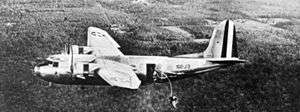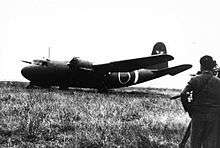Douglas DC-5
| DC-5/C-110/R3D | |
|---|---|
 | |
| US Navy Douglas R3D-2 | |
| Role | Transport |
| Manufacturer | Douglas Aircraft Company |
| Designer | Donald Douglas |
| First flight | 20 February 1939 |
| Introduction | 1940 |
| Retired | 1949 |
| Status | Retired |
| Primary users | KLM United States Navy United States Marine Corps |
| Number built | 12 |
| Developed from | Douglas DB-7 |
The Douglas DC-5 (Douglas Commercial Model 5) was a 16-to-22-seat, twin-engine propeller aircraft intended for shorter routes than the Douglas DC-3 or Douglas DC-4. By the time it entered commercial service in 1940, many airlines were canceling orders for aircraft. Consequently, only five civilian DC-5s were built. With the Douglas Aircraft Company already converting to World War II military production, the DC-5 was soon overtaken by world events, although a limited number of military variants were produced.
Design and development

The DC-5 was developed in 1938 as a 16-22 seat[1] civilian airliner, designed to use either Pratt & Whitney R-1690 Hornet or Wright R-1820 Cyclone radial engines.[2] It was the first airliner to combine shoulder wings and tricycle landing gear, a configuration that is still common in turboprop airliners and military transport aircraft, although the modern versions are actually high wing, as the structure sits atop the fuselage shell rather than intersecting a significant segment.[3] The tricycle landing gear was innovative for transport airplanes. It provided better ground handling and better ground visibility for the pilots. The fuselage was about two feet above the ground, so loading of passengers and cargo was easier than aircraft with the then-standard conventional landing gear.[4] A very early design change was the addition of a 15-degree dihedral to the horizontal tail group to negate a hint of an aeroelasticity problem. The dorsal strake, introduced in minimal form and expanded to full growth on the Boeing 307, is also well developed on the DC-5. Another significant modification was adding exhaust stacks to the engine nacelles, which was retroactively incorporated after the series entered production.[5] An unusual optical trick was applied to the prototype. The top of the vertical stabilizer and the outline of the engine nacelles were painted a darker color following the aircraft's contour, making the tail and engines appear somewhat smaller and the aircraft sleeker.[6]
Prior to the US entry into World War II, one prototype and four production aircraft were built.
Operational history
_over_New_Guinea_1942.jpg)
The prototype DC-5, Douglas serial 411, was built at El Segundo, California with 1,000 hp Wright R-1820-44 Cyclone engines. The aircraft made its first flight on February 20, 1939 with Carl A. Cover at the controls. This sole prototype (in 1940 configured with just eight seats) became the personal aircraft of William Boeing, who named it Rover. It was later impressed into the US Navy and converted for military use as an R3D-3 variant in February 1942.[6]
The first customer for the DC-5 was KLM (Koninklijke Luchtvaart Maatschappij) of The Netherlands. A US domestic carrier, Pennsylvania Central (later renamed Capital Airlines), ordered six and SCADTA, (Sociedad Colomba-Alemana de Transportes Aéreos), ancestor of today's Avianca in Colombia, another two. The four aircraft sold to KLM were used by its colonial subsidiaries. When Douglas factories went into war production, DC-5 production was curtailed to build additional SBD Dauntless dive bombers for the United States Navy (USN) and United States Marine Corps (USMC) and only KLM received the high-winged airliner.
A dozen DC-5s were completed. The first two initially flew between Paramaribo in Surinam (now Suriname) and Curaçao in the Dutch colonial territory of the same name, and the other two operated in the Dutch East Indies for KNILM from Batavia (now Jakarta, Indonesia); the first pair were later transferred to KNILM. Of these four aircraft, three were used for the 1942 evacuation of civilians from Java to Australia; the fourth was damaged in an air strike by the Imperial Japanese Army Air Force at Batavia Kemajoran Airport on February 9, 1942 and abandoned. Japanese forces captured it, and subsequently repaired and tested it in Japan during 1943. This DC-5, painted in camouflage with Japanese Imperial Army Air Force markings, was later used as a transport in the Japanese Home Islands.[6]

The three remaining aircraft made their way safely to Australia where they were sold to the United States Army Air Forces (USAAF) and operated for the Allied Directorate of Air Transport (ADAT). Two were destroyed by the end of 1942, the other was transferred to Australian National Airways (ANA), which operated it throughout the war on behalf of ADAT. In 1944 the USAAF retroactively designated the three aircraft C-110 for administrative purposes.
In 1939, the USN ordered seven aircraft. Three were delivered as R3D-1s, the first of which crashed before delivery. The remaining four were R3D-2s for the USMC and were equipped with 1,015 hp R-1820-44 engines, a large cargo hold, and 22 seats for paratroopers.[6]
After World War II, production of the DC-5 was not resumed because of the abundance of surplus C-47 aircraft released into civil service and converted to DC-3s. In 1948, the last surviving DC-5 was sold by Australian National Airways to another Australian airline, which smuggled it to Israel for military use. The aircraft arrived at Haifa in May 1948, and from there it went to Sde Dov, where its markings were removed and the name "Yankee Pasha – The Bagel Lancer" was crudely painted on the nose by hand. The aircraft joined 103 Squadron at Ramat David Airbase. Because Israel was in the midst of the 1948 Arab–Israeli War, it was occasionally used as a bomber as well as flying transport missions. On bomber missions the aft loading door was removed and bombs were rolled out of the opening "by a judicious shove from a crewman's foot."[7] The operational record of the aircraft is in dispute as authoritative sources do not verify its combat service.
When the war ended and 103 Squadron moved, the DC-5 was left behind at Ramat David.[8] It eventually found its way to a technical school where it was used extensively as a ground instruction airframe at Haifa Airport. When it was no longer serviceable due to a lack of spares, the airframe was stripped of its engines and instruments and the last DC-5 was reduced to scrap in Israel sometime after 1955.[9]
Variants
- Prototype DC-5
- The prototype was sold to William E. Boeing as a personal aircraft, modified to fit 16 passenger seats.
- DC-5
- The basic passenger version: five aircraft were built, one prototype and four production aircraft.
- C-110
- Rectroactive designation for three former Indonesian-registered KNILM aircraft that had been bought by the United States Army Air Forces for service in Australia on behalf of the Allied Directorate of Air Transport in March 1942.[10]
- R3D-1
- Military version of the DC-5 built for the United States Navy as 16-seat personnel carriers. Three were produced. One crashed at Mines Field, June 1, 1940. Another was retired in January 1946. The third is believed to have been used briefly by Gen. Douglas MacArthur; retired January 1945.
- R3D-2
- Military version of the DC-5 built for the United States Marine Corps as 22-seat paratrooper version, four were produced.
- R3D-3
- The prototype, registered NC21701, sold to the military in 1942.[11] Withdrawn from use 30 June 1946 in the United States at Naval Aeronautical Laboratory, Banana River, Florida.
Operators
Military operators
- Australia
- Israel
- Israeli Air Force operated one DC-5.
- Japan
- Imperial Japanese Army Air Force operated one captured Dutch DC-5.
- United States
- United States Army Air Forces three impressed in Australia in 1942 and designated C-110[10]
- United States Navy operated two R3D-1s, a further aircraft crashed before delivery.[12] In 1942 the prototype was bought.[13]
- United States Marine Corps operated four R3D-2s.[12]
Civil operators
- Australia
- Australian National Airways
- New Holland Airways
- Dutch West Indies
- KLM West Indies two aircraft delivered new in April and May 1940, from 1941 operated by KNILM, still owned by KLM.
- Dutch East Indies
- KNILM two aircraft delivered to KLM in June/July 1940, sold to the Netherlands East Indies Government and leased to KNILM[14], two further aircraft transferred from KLM West Indies in 1941. Three escaped to Australia in February 1942 and one damaged in a Japanese air raid in February 1942 was repaired and used by the Japanese Army.
- United States
- William E. Boeing operated one DC-5 delivered in 1940, sold to United States Navy in 1942.[15]
Specifications (DC-5)
Data from McDonnell Aircraft since 1920 [16]
General characteristics
- Crew: three
- Capacity: 18-24 passengers
- Length: 62 ft 2 in (18.96 m)
- Wingspan: 78 ft (23.77 m)
- Height: 19 ft 10 in (6.04 m)
- Wing area: 824 ft² (76.55 m²)
- Empty weight: 13,674 lb (6,243 kg)
- Loaded weight: 20,000 lb (9,072 kg)
- Powerplant: 2 × Wright GR-1820-F62 Cyclone, 900 hp (671 kW) each
Performance
- Maximum speed: 230 mph (200 kn, 370 km/h) at 7,700 ft (2,345 m)
- Cruise speed: 202 mph (176 kn, 325 km/h)
- Range: 1,600 mi (1,391 nmi, 2,575 km)
- Service ceiling: 23,700 ft (7,225 m)
- Rate of climb: 1,585 ft/min (8.1 m/s)
See also
Related development
Related lists
References
- Notes
- ↑ "DC-5/C-110 Transport". Boeing. Retrieved August 8, 2017.
- ↑ Delta 1993, p. 14.
- ↑ Delta 1993, p. 15.
- ↑ Juptner 1994, p. 106
- ↑ Delta 1993, pp. 15–16.
- 1 2 3 4 Verstappen, Harrie. "Douglas DC-5: 'The Forgotten Douglas'." Curassow: The Dutch Caribbean island of Curaçao. via vrcurassow.com, September 4, 2001. Retrieved: June 6, 2010.
- ↑ Delta 1993, p. 65.
- ↑ Norton 2004, p. 109.
- ↑ Delta 1993, pp. 64–65.
- 1 2 Andrade 1979, p. 84
- ↑ William E. Boeing
- 1 2 Andrade 1979, p. 214
- ↑ FAA file NC21701
- ↑ Piet Kok - Douglas DC-5, page 96.
- ↑ FAA file NC21701
- ↑ Francillon 1979, p. 313.
- Bibliography
- Delta, Mike. "Forgotten Five: The history of the very limited production of the Douglas DC-5 Airliner." Air Classics, Volume 29, Number 7, July 1993. ISSN 0002-2241.
- Francillon, René J. McDonnell Douglas Aircraft since 1920. London: Putnam, 1979. ISBN 0-370-00050-1.
- Jupnter, Joseph P. U.S. Civil Aircraft Series, Vol 8.. Blue Ridge Summit, PA: TAB Books, 1994. ISBN 0-8306-4373-7.
- Norton, Bill. On The Edge: A History of the Israeli Air Force and its Aircraft since 1947. Hinckley, UK: Midland Counties Publications, 2004. ISBN 1-85780-088-5.
- Pearcy, Arthur. Douglas Propliners: DC-1 – DC-7. London: Airlife, 1995. ISBN 1-85310-261-X.
External links
| Wikimedia Commons has media related to Douglas DC-5. |